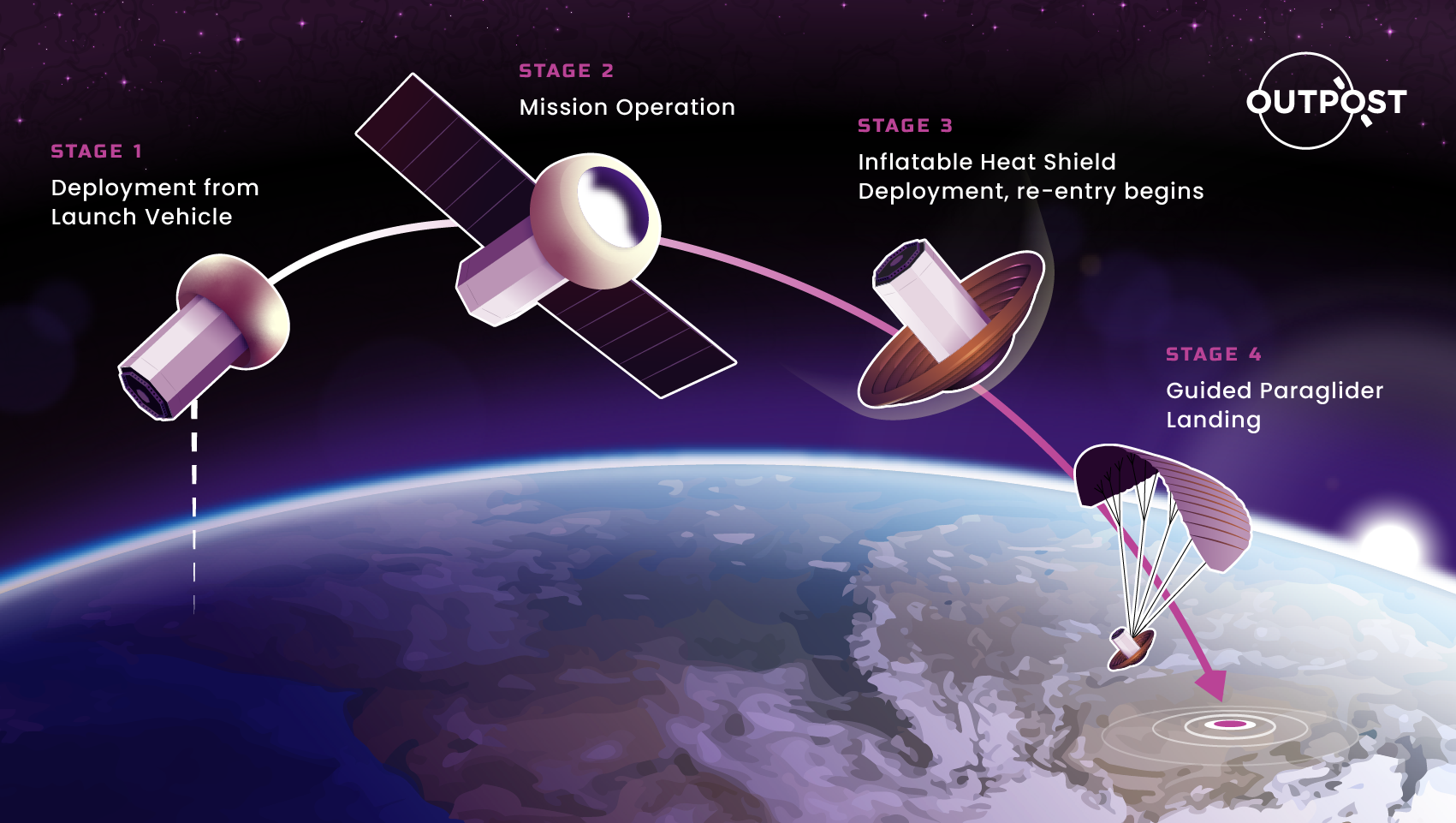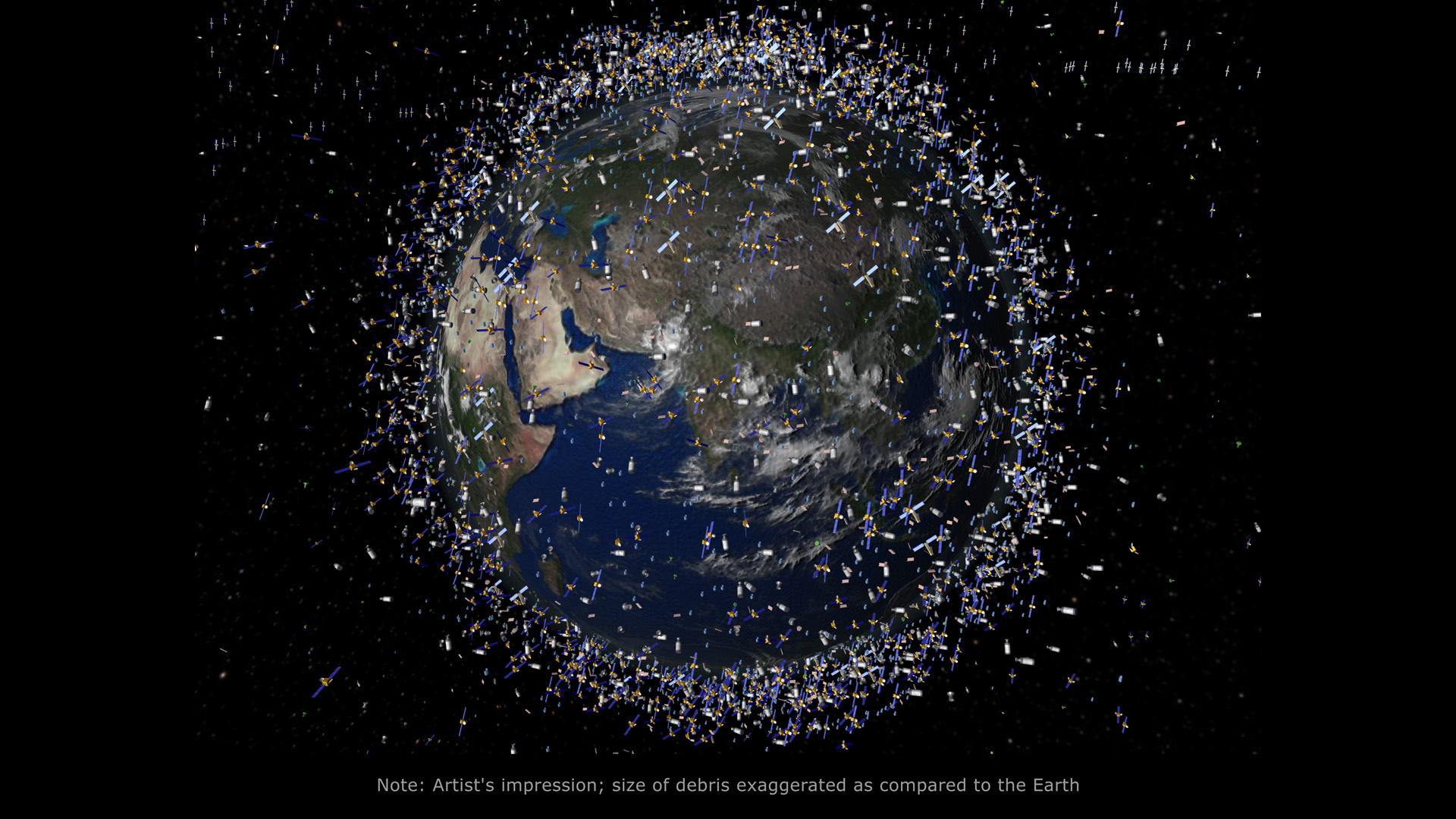Wild space 'ferry' concept uses paragliders to return satellites and science to Earth
Outpost recently tested a stratospheric paraglider to return space tech ahead of orbital ventures for NASA and other companies later in the 2020s.

Dropping in twice from a dozen miles high in the stratosphere, a paraglider safely touched down on Earth in a key milestone aimed at removing space debris.
The high-altitude tests in April 2022 were the flying start to Outpost Technologies' vision: to gently return used space hardware back to Earth for reflight or examination. That hardware could be satellites low on fuel, or used-up science experiments on the International Space Station (ISS).
There's an urgent need to help with both industries. Satellites are rapidly cluttering up low Earth orbit and adding space debris that threatens the infrastructure we need for weather forecasts and telecommunications. Meanwhile, the ISS is so crowded with two decades of old experiments and equipment that it is running out of room to host new ones; cargo ships cannot empty it fast enough any more.
Related: Russian space debris forces ISS to dodge, postpones spacewalk
"I believe that what we're what we're developing will basically put an end to space debris," Outpost CEO Jason Dunn told Space.com in December 2022. NASA is paying attention to that: the agency awarded Outpost an early-stage contract on Dec. 6 to design a "Cargo Ferry" version of Outpost's technology targeted for ISS payload return.
Dunn pledges the ferry will be ready long before ISS is scheduled to retire in 2030, to bring home smaller experiments that typically are completed within a few weeks of arriving at the huge complex. Larger payloads would still be flown home on traditional cargo ships, like SpaceX's Dragon, he said.
Dunn knows the ISS through his first major orbital venture, Made In Space, which he founded in 2010. The company is best known for co-producing the first 3D printer for the ISS. Ironically, the printer is still stuck in orbit awaiting a cargo ship slot despite the Smithsonian Institution pledging to take it when it comes home.
Get the Space.com Newsletter
Breaking space news, the latest updates on rocket launches, skywatching events and more!
The space ferry project was born not only to return hardware like that, but to deal with the ongoing problem of space launching costs and space debris, Dunn said. "As I got more involved in the space industry and my career, a few things were nagging at me ... so much effort, so much money was being put into getting things off the planet, and hardly any effort in getting things back to the planet."
Related: Chinese rocket body disintegrates into big cloud of space junk

Traditionally, Dunn said, we continue to produce throwaway "single mission" items for space that then need to be brought back to Earth. That is slowly changing with the introduction of reusable rocket stages via Blue Origin and SpaceX, and early-stage satellite refueling first demonstrated in-orbit in 2020. But Dunn said more should be done, which inspired him to start Outpost.
"I'm a huge believer in the idea of millions of people living and working in space one day, and we, frankly, aren't going to have that happen if if we don't chart a better path," Dunn said.

The plan is to fetch the satellites in orbit with a small vehicle and then to guide them through the atmosphere via a paraglider, at subsonic speeds; this would allow for an intact landing on Earth without the hardware burning up in the atmosphere. To bolster the business case (and profit), Outpost would fly up satellites during launch for deployment, then pick up older satellites in the same orbit to return to Earth.
"We robotically guide the paraglider and the satellite to a landing site, and in precision landing flight tests that we've done, we've been within 5 meters [16 feet] of our target," Dunn said. By comparison, NASA's successful test of a "flying saucer" inflatable Mars heat shield high in Earth's atmosphere in November came down within 10 miles (16 kilometers) of its landing target.
So far Outpost's ideas are in early designs and tests, but the company is growing quickly to meet forecast demand. Now standing at 14 employees from just two a year ago, Outpost raised $7 million in seed funding last summer on the strength of their reusable satellite ventures. And as new space stations likely replace the ISS in the 2030s, Dunn says, Outpost probably can contribute to their cargo needs as well.
Elizabeth Howell is the co-author of "Why Am I Taller?" (ECW Press, 2022; with Canadian astronaut Dave Williams), a book about space medicine. Follow her on Twitter @howellspace. Follow us on Twitter @Spacedotcom or Facebook.
Join our Space Forums to keep talking space on the latest missions, night sky and more! And if you have a news tip, correction or comment, let us know at: community@space.com.

Elizabeth Howell (she/her), Ph.D., was a staff writer in the spaceflight channel between 2022 and 2024 specializing in Canadian space news. She was contributing writer for Space.com for 10 years from 2012 to 2024. Elizabeth's reporting includes multiple exclusives with the White House, leading world coverage about a lost-and-found space tomato on the International Space Station, witnessing five human spaceflight launches on two continents, flying parabolic, working inside a spacesuit, and participating in a simulated Mars mission. Her latest book, "Why Am I Taller?" (ECW Press, 2022) is co-written with astronaut Dave Williams.
-
Wes I Does space debris and trash have any economic value while still in orbit? Can any of it be economically repaired, repurposed or remanufactured while in orbit, rather than returned to Earth?Reply -
billslugg Trash has pretty much no value in space and would be extremely expensive to match orbits such that it could be caught. It would cost about the same amount of money to move a similar amount of mass from Earth to Earth orbit.Reply -
Zayvra It's either that or...Reply
Tow them into a giant magnet, & use the heap, as moorage for ships. Then, creating a space-station island, for traveling spaceships to dock and replenish supplies. -
bolide Matching location and orbit with the junk is the hardest part. I wonder if we could put a big electromagnet in orbit in a crowded area, then turn it on only when some piece of junk is passing nearby, to deflect the junk out of its orbit toward the atmosphere.Reply
Zayvra said:It's either that or...
Tow them into a giant magnet, & use the heap, as moorage for ships. Then, creating a space-station island, for traveling spaceships to dock and replenish supplies. -
billslugg The problem with using magnetism in trying to influence an object is that the strength of the magnetic field falls off as the cube of the distance to the object.Reply
This is for two reasons, first the magnetic field falls off by the square of the distance as do EM waves. Second, the magnetic field is produced by a dipole of displaced charge which appears smaller as one moves away by the first power. Add the two and you get the cube.
Junk in orbit would better be slowed by hitting with a laser on the leading face. This could be done from great distance, relative speed is no issue, could even be done from the ground with adaptive optics.
(Edited to get my powers straight.) -
RussellB10 What if we gathered up all the items in orbit around the Earth which are small enough to burn up in the atmosphere, and direct them into the atmosphere? Sizing is an issue. Can be done with a kind of filter. Large sail-like object to collect the objects, with a filter, excluding objects above a certain size, and then redirecting the small objects into the atmosphere. The engineering challenges on this would be considerable. I imagine that the density of the debris in orbit is very low, although it is obviously getting to a point where it is an issue. Low density makes this kind of idea less feasible.Reply -
RussellB10 What percentage of the objects in orbit are small enough to burn up safely in the atmosphere? What percentage by mass?Reply -
RussellB10 With magnetic attraction, a very slow process of deflection might be acceptable, with significant amounts collected over periods of, say, years. The other aspect here is that the magnets may deflect objects large enough to pose a threat, into the atmosphere.Reply -
billslugg There are very few objects in orbit large enough to survive reentry. Virtually all space junk could be deorbited safely.Reply
Matching the orbit of a piece of debris is extremely costly. Any scheme designed to affect its orbit by getting near the object and matching its speed is not practical.
Spacecraft are made of titanium, aluminum, plastic, copper, stainless steel, none of which are significantly magnetic. -
bolide Reply
The gathering up is the hard part, the rest is simple. But to collect an item, you have to match up speed & location with it. Otherwise all you'd get is a collision at thousands of mph, destroying your collector and creating even more debris. And this is required for each and every little bit of junk that you collect.RussellB10 said:What if we gathered up all the items in orbit around the Earth which are small enough to burn up in the atmosphere, and direct them into the atmosphere? Sizing is an issue. Can be done with a kind of filter. Large sail-like object to collect the objects, with a filter, excluding objects above a certain size, and then redirecting the small objects into the atmosphere. The engineering challenges on this would be considerable. I imagine that the density of the debris in orbit is very low, although it is obviously getting to a point where it is an issue. Low density makes this kind of idea less feasible.









